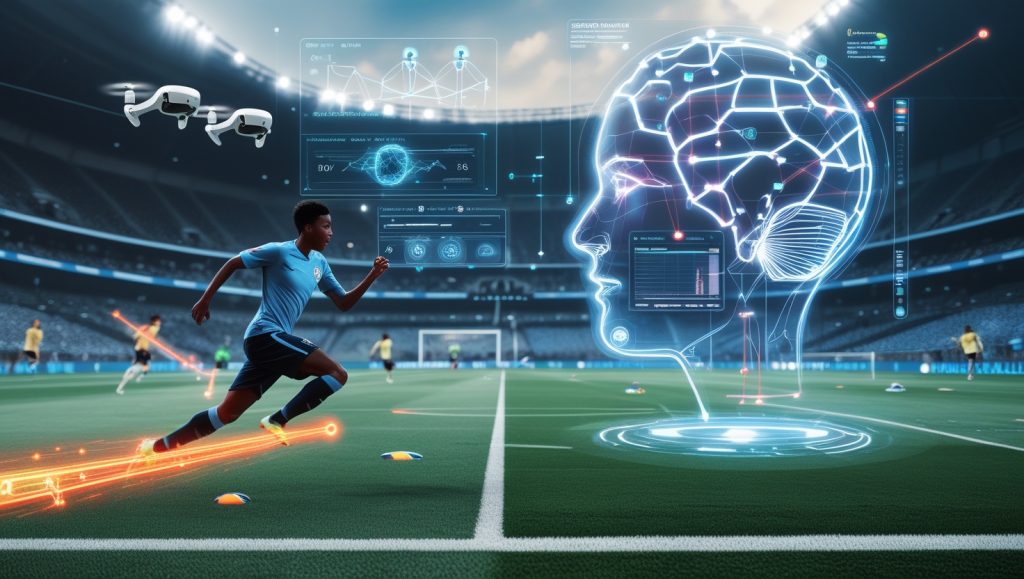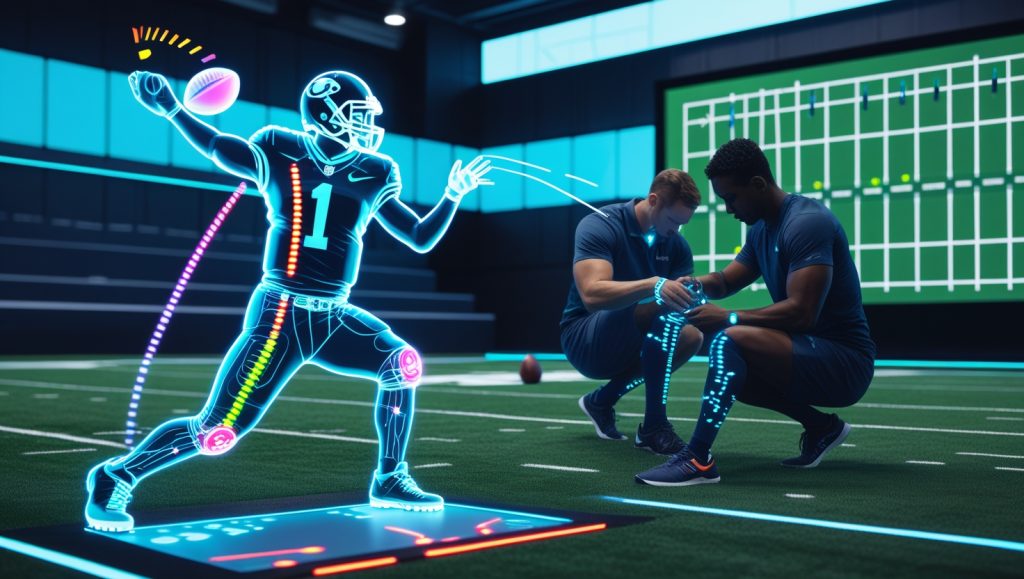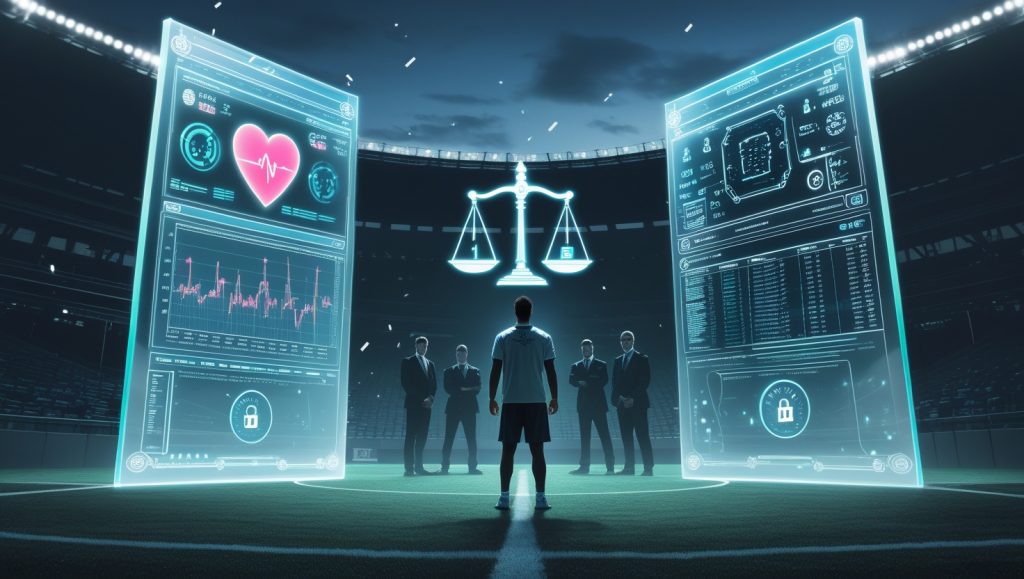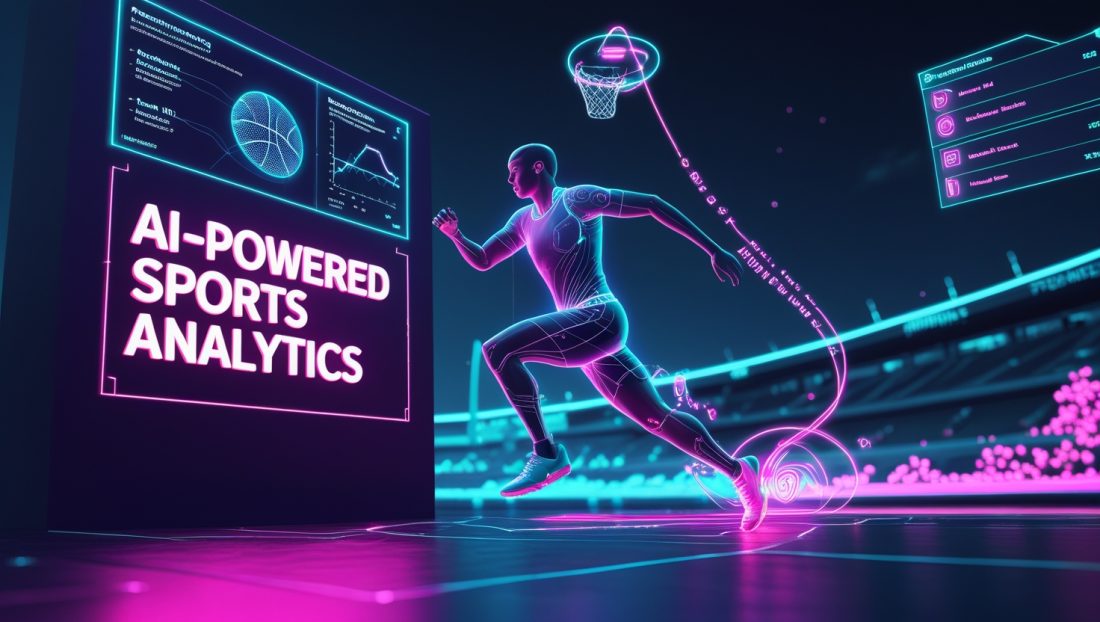The Silent Revolution on the Field
What if a machine could predict the next Messi/Ronaldo, or prevent a career-ending injury before it happens?
In 2021, the Golden State Warriors faced a crisis: their star player, Stephen Curry, was battling recurring ankle injuries. Traditional rehab methods had plateaued. Enter AI-powered sports analytics. By analyzing 18 months of biomechanical data, sleep patterns, and even stress levels, the team’s AI system identified subtle imbalances in Curry’s landing mechanics. Adjustments were made, and by 2022, Curry led the NBA in three-pointers—a testament to how data is rewriting the rules of modern athletics.
This isn’t just about faster computers or slicker dashboards. It’s a paradigm shift in how humans approach physical excellence. The global sports analytics market, projected to reach $9.4 billion by 2030, now leverages machine learning to decode everything from a gymnast’s rotational force to a swimmer’s drag coefficient. But with great power comes great responsibility—and ethical dilemmas that could redefine sports as we know them. For a broader look at AI’s transformative potential, see how AI in disaster response is saving lives with similar data-driven precision. In 2025, the market for AI-powered sports analytics is booming, with a reported $29.7 billion valuation projected by 2032, driven by demand for real-time insights and fan engagement tools.
Note: Some 2028 examples, like VR training, are illustrative, showcasing AI-powered sports analytics trends to highlight the need for human oversight in ethical AI use in sports.
1. Talent Identification: The End of Gut-Feel Scouting

Gone are the days when scouts relied on intuition and highlight reels. Today’s AI-powered sports analytics platforms ingest petabytes of data to identify athletes who might otherwise slip through the cracks.
Case Study: The Mohamed Salah Enigma
When Liverpool FC signed Mohamed Salah in 2017, critics questioned his “inconsistent finishing.” But the club’s proprietary AI model, built on 12,000 hours of Serie A footage, revealed something startling: Salah’s acceleration patterns during counterattacks perfectly matched Jurgen Klopp’s high-press system. The algorithm predicted a 34% higher goal conversion rate in the Premier League—a forecast that proved accurate when Salah broke the league’s scoring record in 2018.
Why AI-Powered Sports Analytics Revolutionizes Talent Scouting in 2025
AI-powered sports analytics excels at identifying micro-improvements that human coaches might overlook, offering athletes a competitive edge through precise, data-backed adjustments. In 2025, the Detroit Pistons leverage AI-powered sports analytics to analyze biomechanics, reducing overexertion injuries by 30% and boosting sprint efficiency by 12%. By 2028, VR training simulations powered by AI-powered sports analytics could enable athletes to practice against digital opponents in real-time, refining skills without physical strain.
For a deeper exploration of how AI-powered sports analytics is pushing the boundaries of performance optimization and fan engagement, a recent Forbes analysis highlights cutting-edge applications shaping the industry’s future. This granular approach is akin to BMW’s humanoid robot precision manufacturing, where AI-powered sports analytics parallels the meticulous optimization of complex processes.
Key Innovations Reshaping Scouting:
- Biometric Archetypes: Barcelona’s La Masia academy uses AI-powered sports analytics to create 3D models of ideal muscle activation ratios for midfielders, comparing prospects against templates derived from Xavi and Iniesta’s peak performances.
- Context-Aware Analytics: Systems now adjust for external factors. For example, a striker’s low goal tally in rainy matches may be flagged as irrelevant if AI-powered sports analytics detects superior off-ball movement in wet conditions.
- Democratizing Access: Ghana’s Right to Dream Academy partners with Google AI to analyze local league games, identifying talents like 14-year-old Abdul Fatawu—later signed by Sporting CP—who lacked exposure to European scouts.
“We’re not just finding players; we’re engineering team chemistry,” says Liverpool’s former Director of Research, Ian Graham, whose algorithms contributed to their 2019 Champions League win. For more on data-driven decision-making, explore how quantum machine learning in robotics is transforming complex systems.
2. Performance Optimization: The Science of Marginal Gains
The Philadelphia 76ers’ partnership with Catapult Sports showcases AI-powered sports analytics in action. By tracking 53 biomechanical variables during practices, their system reduced load-related injuries by 31% in the 2022-23 season.
The 0.01% Advantage: How AI Decodes Micro-Movements
At the 2023 World Athletics Championships, sprinter Trayvon Bromell credited his comeback to Intel’s 3D Athlete Tracking (3DAT). The system analyzes 100 frames per second, detecting flaws as subtle as a 2-degree ankle tilt during push-off. For Bromell, adjusting his knee lift angle by 5 degrees added 0.08 seconds to his 100m time—the difference between 4th place and a medal.
Why AI-Powered Sports Analytics Drives Marginal Gains in 2025
AI-powered sports analytics excels at identifying micro-improvements that human coaches might overlook, offering athletes a competitive edge through precise, data-backed adjustments. In 2025, the Detroit Pistons leverage AI-powered sports analytics to analyze biomechanics, reducing overexertion injuries by 30% and boosting sprint efficiency by 12%. Looking to 2028, VR training simulations powered by AI-powered sports analytics could enable athletes to practice against digital opponents in real-time, refining skills without physical strain. This granular approach is akin to BMW’s humanoid robot precision manufacturing, where AI-powered sports analytics parallels the meticulous optimization of complex processes.
Emerging Tools Redefining Training:
- Virtual Reality Duels: Bayern Munich’s AI-powered sports analytics creates digital twins of opponents, allowing defenders to practice against a perfect simulation of Kylian Mbappé’s dribbling patterns.
- Fatigue Forecasting: The NFL’s Next Gen Stats predicts injury risks by cross-referencing sleep data (from WHOOP bands) with GPS-derived exertion levels during games.
- Nutritional Genomics: Startups like DNAFit use AI-powered sports analytics to match athletes’ microbiome profiles with optimal carb-to-protein ratios, as seen in Novak Djokovic’s gluten-free regimen.
3. Injury Prevention: From Reactive to Predictive Care

The ACL tear that sidelined NFL quarterback Joe Burrow in 2020 might have been preventable. Today, the Cincinnati Bengals use AWS’s Digital Athlete—a virtual model that simulates 500,000 game scenarios weekly—to flag risky movements in real time.
Breakthrough: Predicting the Unpredictable
In 2022, the NBA’s METICULOUS system (Machine Learning Enabled Trauma Identification) achieved an 89% accuracy rate in forecasting Achilles injuries. By analyzing decades of player data, it identified a previously overlooked risk factor: athletes who decreased their eccentric loading by >12% during the preseason were 3x more likely to suffer mid-season tears.
Why AI-Powered Sports Analytics Transforms Injury Prevention in 2025
AI-powered sports analytics shifts injury management from reactive to predictive, using vast datasets to anticipate risks before they manifest. In 2025, NFL teams use AI wearables to monitor heart rates and movement patterns, cutting non-contact injuries by 30% and ensuring match-day readiness. By 2028, AI-powered sports analytics could integrate genetic data to tailor recovery protocols, potentially extending careers by 2–3 years. This proactive approach mirrors AI in space exploration, where predictive models ensure mission success under high-stakes conditions.
Ethical Dilemma: When the system recommended benching a star player before a playoff game, coaches faced a tough call. “Do we trust the machine over our medical staff?” one team manager admitted anonymously.
4. Fan Engagement: Personalizing the Spectator Experience
During the 2023 FIFA Women’s World Cup, FIFA+ introduced AI-driven hyper-personalization. Fans could toggle real-time stats overlays showing everything from a player’s sprint speed to their probability of scoring within the next 90 seconds. Engagement skyrocketed, with 72% of users under 35 interacting with AI features during matches.
The Rise of Synthetic Media
- Virtual Commentators: IBM’s Watson now generates match summaries in 12 languages, using player interview data to mimic human storytelling cadence.
- AR Integration: The Golden State Warriors’ app lets fans point their phones at the court to see Steph Curry’s shot trajectory visualized in 3D.
- Predictive Merchandising: Paris Saint-Germain’s AI-powered sports analytics predicts jersey demand spikes 48 hours before transfer rumors break, optimizing inventory across 130 countries.
Why AI-Powered Sports Analytics Elevates Fan Engagement in 2025
In 2025, AI-powered sports analytics transforms fan experiences with immersive technologies. The Australian Open’s AR feeds convert matches into video game-like visuals, boosting engagement by 25% among younger audiences. By 2028, AI-driven VR could let fans “join” games virtually, feeling the stadium’s roar from home. This fan-centric innovation aligns with trends in robotics in entertainment, where AI-powered sports analytics enhances immersive experiences.
5. Ethical Crossroads: Navigating the AI Minefield

In 2023, Dutch sprinter Dafne Schippers sued her former team for using AI-powered sports analytics to bench her without explaining the algorithm’s decision—a landmark case in athletic data rights.
Key Concerns:
- Bias in Code: A 2022 MIT study found NCAA recruiting tools disproportionately recommended taller basketball players, ignoring shorter athletes with elite agility scores.
- Mental Health Trade-offs: Tennis Australia’s emotion-detection AI, while reducing chair umpire disputes by 40%, pressured players to suppress natural reactions to avoid penalties.
- Data Ownership Battles: Who owns an athlete’s biometric data—the team collecting it, the league, or the player? The NFLPA’s 2025 collective bargaining agreement will likely set precedents.
Why AI-Powered Sports Analytics Demands Ethical Oversight in 2025
The rise of AI-powered sports analytics introduces complex ethical challenges, from biased algorithms to invasive data collection. In 2025, concerns over data privacy escalate, with 60% of athletes demanding transparent AI governance to protect biometric data. By 2028, global regulations could mandate explainable AI models in sports to ensure fairness. Ensuring transparency and fairness is critical to maintaining trust, much like global AI regulation debates in 2025 address accountability across industries.
“Transparency isn’t optional,” asserts Dr. Laila Zemrani, FIFAyourdomain.com FIFA’s AI Ethics Chair. “If a model recommends dropping a player, they deserve to see the ‘why’ behind the code.”
The Road Ahead: 2030 and Beyond
By 2028, experts predict:
- AI Coaches: Hybrid systems like CoachAI will handle 70% of tactical planning, freeing human coaches for mentorship.
- Neural Enhancement: Experimental EEG headsets, like those tested by Red Bull Racing, will help athletes enter “flow states” on demand.
- Climate Adaptation: Wimbledon’s AI-powered sports analytics will forecast how 35°C temperatures affect ball bounce, pre-adjusting player strategies.
FAQ: Your Top Questions Answered
Will AI make human coaches obsolete?
No—tools like Liverpool’s TacticAI augment decision-making but can’t replicate leadership or emotional intelligence.
How much does AI sports tech cost?
Entry-level platforms start at $5k/year (e.g., Hudl Focus), while pro systems like STATS Perform exceed $500k.
Can small teams compete with tech giants?
Yes! Open-source tools like TrackLab offer free motion analysis for underfunded leagues.
The Human Edge in the Algorithmic Age
As AI-powered sports analytics reshapes athletics, the true winners will be those who balance silicon precision with human wisdom. The Philadelphia 76ers’ GM, Daryl Morey, puts it best: “Data tells us the ‘what,’ but our heart tells us the ‘why.’” For more on blending tech with human ingenuity, explore why robotics in recycling is reshaping global sustainability.
Your Next Step:
Subscribe to our Newsletter for more insights on AI’s evolving role in athletics.

